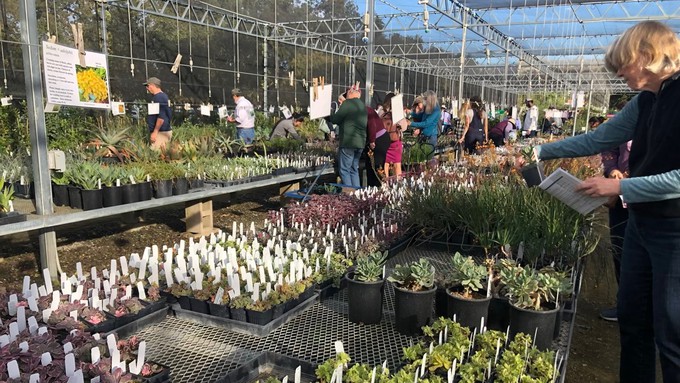
Hundreds of water-wise selections available; see them in bloom

The succulent tables always are popular spots with shoppers at the UC Davis Arboretum Teaching Nursery plant sales. Kathy Morrison
What kind of water-wise plants will thrive in your garden? It’s likely you’ll find them Saturday at the UC Davis Arboretum’s public plant sale.
On Saturday, April 29, the Arboretum Teaching Nursery at UC Davis hosts its biggest public sale of the spring. From 9 a.m. to 1 p.m., everyone is invited to browse and buy.
Members of Friends of the Arboretum will get a head start on new offerings. Friends members get early access at 8:30 a.m. Not a Friend? Not a problem. New Friends can join at the gate or in advance online with instant perks: a $10-value appreciation gift and 10% off all purchases.
The Arboretum Teaching Nursery is located on Garrod Drive near UCD’s small animal veterinary teaching hospital on the university campus.
Before the event, prospective shoppers can check out the plant list and photos on the arboretum’s website at https://arboretum.ucdavis.edu/plant-sales. The inventory list is now up to date – and very tempting.
This spring’s inventory features hundreds of water-wise perennials, shrubs, bulbs, ground covers and trees – all proven to love growing in the Central Valley. That includes California natives as well as plants from other Mediterranean climates.
Recent warmer weather has prompted many of these plants into bloom. See well-established specimens in the nursery’s demonstration gardens.
Featured in this sale are the ever-popular Arboretum All-Stars – tough, easy-care, low-water flowering plants with added benefits; most support pollinators and native wildlife.
If you can’t make Saturday, there’s only one more chance to shop the Arboretum Teaching Nursery this spring. A giant clearance sale is planned for 9 a.m. to 1 p.m. May 13.
Details and directions: https://arboretum.ucdavis.edu.
Comments
0 comments have been posted.Sacramento Digs Gardening to your inbox.
Sites We Like
Garden Checklist for week of July 21
Your garden needs you!
* Keep your vegetable garden watered, mulched and weeded. Water before 8 a.m. to reduce the chance of fungal infection and to conserve moisture.
* Feed vegetable plants bone meal, rock phosphate or other fertilizers high in phosphate to stimulate more blooms and fruiting. (But wait until daily high temperatures drop out of the 100s.)
* Don’t let tomatoes wilt or dry out completely. Give tomatoes a deep watering two to three times a week.
* Harvest vegetables promptly to encourage plants to produce more. Squash especially tends to grow rapidly in hot weather. Keep an eye on zucchini.
* Pinch back chrysanthemums for bushy plants and more flowers in September.
* Remove spent flowers from roses, daylilies and other bloomers as they finish flowering.
* Pinch off blooms from basil so the plant will grow more leaves.
* Cut back lavender after flowering to promote a second bloom.
* It's not too late to add a splash of color. Plant petunias, snapdragons, zinnias and marigolds.
* From seed, plant corn, pumpkins, radishes, winter squash and sunflowers.